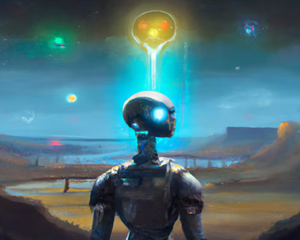Even with these space-based observatories, verifying that a planet orbits another star is time-consuming and difficult.
即使有了這些天基觀測站,驗證一顆行星是否繞著另一顆恒星運行也是耗時且困難的。
These telescopes can't visualize the planet itself -- just as how any common telescope can see Jupiter or Saturn.
這些望遠鏡無法看到行星本身,就像普通望遠鏡可以看到木星或土星一樣。
Instead, they confirm its existence indirectly.
相反,他們間接證實了它的存在。
That involves measuring almost imperceptible blips in a star's brightness that could indicate a passing planet.
這涉及到測量恒星亮度中幾乎難以察覺的光點,這些光點可能表明有一顆行星經(jīng)過。
Astronomers scrutinize changes in starlight, known as light curves, to identify potential planets.
天文學家仔細觀察星光的變化(稱為光變曲線)來識別潛在的行星。
Then, to prove one exists, Earth-based telescopes measure how a star wobbles under its planet's gravitational tug.
然后,為了證明恒星的存在,地球上的望遠鏡測量了一顆恒星在其行星引力作用下如何擺動。
Once a planet is found, understanding what it is like is even trickier.
一旦發(fā)現(xiàn)一顆行星,要了解它是什么樣子就更加困難了。
But astronomers can make assumptions based on size and distance from stars.
但天文學家可以根據(jù)恒星的大小和距離做出假設。
Thanks to these painstaking efforts, astronomers now know of at least 5,600 planets orbiting distant stars in the Milky Way.
由于這些艱苦的努力,天文學家現(xiàn)在知道銀河系中至少有5600顆行星繞著遙遠的恒星運行。
Some are huge gas giants bigger than Jupiter and Saturn; some are hot rocks smaller than Mars; most are worlds made of gas, rock, or both, often between the sizes of Earth and Neptune.
有些是比木星和土星還大的氣態(tài)巨行星;有些是比火星還小的熱巖石;大多數(shù)是由氣體、巖石或兩者組成的世界,大小通常在地球和海王星之間。
None resemble home. None have the conditions or the chemicals necessary for life as we know it.
沒有一個地方像家園。沒有一個具備我們所知的生命所需的條件或化學物質(zhì)。
But AI could reveal something different, because it can take an even deeper look.
但人工智能可以揭示一些不同的東西,因為它可以進行更深入的觀察。
In 2018 Valizadegan and his team began building a machine learning program to speed up exoplanet-hunting efforts.
2018年,瓦利扎德甘和他的團隊開始建立機器學習程序,以加快系外行星搜尋工作。

They trained the software on data signifying confirmed planets as well as false positives, like binary stars that eclipse each other and can be mistaken for passing planets.
他們對軟件進行了數(shù)據(jù)訓練,這些數(shù)據(jù)表示已確認的行星以及誤報,例如相互遮擋并可能被誤認為經(jīng)過的行星的雙星。
They called it ExoMiner and put it to the test on the Kepler telescope's archive of observations.
他們將其命名為ExoMiner,并在開普勒望遠鏡的觀測檔案中對其進行了測試。
"I did not know how much we were going to be rewarded," Valizadegan says.
“我不知道我們會得到多少獎勵,”瓦利扎德甘說。
But his model quickly identified 370 previously unknown exoplanets.
但他的模型很快就辨識出了370顆以前未知的系外行星。
"At first there was a lot of resistance from the exoplanet scientists, who said, 'No, this should not be labeled as a planet.' But over time, they got more confident."
“一開始,系外行星科學家們提出了很大的阻力,他們說,‘不,這不應該被貼上行星的標簽。’但隨著時間的推移,他們變得更加自信。”
ExoMiner has yet to be overruled, he says.
瓦利扎德甘說,ExoMiner尚未被否決。
None of these 370 new planets are like Earth -- or any other planet in our solar system, for that matter.
這370顆新行星中沒有一顆像地球,也不像我們太陽系中的任何其他行星。
One new world, dubbed Kepler-495 c, is about twice the size of Earth and zips around its sunlike star at a blistering pace, every six days.
一個被稱為Kepler-495 c的新世界大約是地球大小的兩倍,每六天就以驚人的速度繞著它的類日恒星旋轉(zhuǎn)一圈。
Another, called Kepler-27 d, is almost as big as Neptune, or about eight times as big as Earth, and experiences a speedy six-and-a-half-day year.
另一個名為開普勒-27 d,幾乎與海王星一樣大,大約是地球的八倍,并且經(jīng)歷了快速的六天半一年。
Fried by their stars' heat and radiation, these planets are likely uninhabitable.
這些行星被恒星的熱量和輻射煎炸,很可能無法居住。
Valizadegan says ExoMiner is just the start of using AI to solve this ultimate needle-in-a-haystack problem.
瓦利扎德甘表示,ExoMiner只是使用人工智能解決這一終極大海撈針問題的開始。
A new generation of planet-hunting telescopes launching in the next decade will bring ever vaster quantities of starlight down to Earth.
未來十年發(fā)射的新一代行星搜尋望遠鏡將為地球帶來更多的星光。
Future AI planet spotters, building on ExoMiner's success, are also in development.
基于ExoMiner的成功,未來的人工智能行星觀測器也在開發(fā)中。
In fact, researchers now believe that AI can be useful in hunting for not merely new worlds but also conditions most likely to host life.
事實上,研究人員現(xiàn)在相信人工智能不僅可以用于尋找新世界,還可以用于尋找最有可能存在生命的條件。












